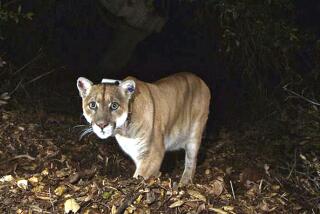Balancing Wildlife and Urban Life
- Share via
NEW YORK — Some weeks ago, New York City newspapers published details of a plan to remodel a section of Central Park that included a pond; the project’s purpose was to make room for new audio equipment to improve the amplification of summertime outdoor concerts.
The news, however, was that the proposed changes of scenery had been vetoed by environmentalists, because the pond in its present shape is a breeding ground for several species of dragonfly, and the scientists feared that alterations in its shoreline would disturb, impair or possibly destroy these insects’ capacity to reproduce. We should cherish dragonflies; the adults eat other insects and the young feed on mosquito spawn. Had the original plan gone through, and the dragonflies been “disappeared” like a Latin American opposition, summer concert-goers might have heard the philharmonic accompanied by the whine of mosquitoes while itching, scratching and slapping. Preserving the dragonflies was a favor to the park’s human users rather than a disinterested gesture to a lesser species.
This was the first time, to my knowledge, that our city responded to an ecological alert on behalf of an insect. The citizens were both pleased at, and bemused by, the sensitivity of our ecologists and our laws. Our previous environmental to-do involved a fish. As you may recall, last year our ambitious Westway project--a highway and park along the Hudson River bank of Manhattan--was quashed after a decade of litigation on the grounds that the construction would threaten the Hudson’s striped bass. I myself am not certain that forestalling Westway was the triumph of virtue and reason that its victorious opponents claimed. The bass have proved adaptable in the past, and the park beside the river would have been a delightful amenity, particularly since the current riverside decor is a sequence of derelict docks. My hunch is that the bass were invoked because many Americans have become disillusioned with epic projects, the kind of grand-scale public works that were so admired from the 1930s to the 1960s.
Another case in point is the Alabama dam that was vetoed some years back to protect the snail darter, a fish that, after all, turned out to be in no peril. Building a dam no longer appears, as it once did, an unquestionably forward-looking or progressive step.
Environmental-protection laws have allowed us time to think again, to take a second look at our ideas, values and facts. In retrospect, we can recognize that the human desire to control or modify nature with monumental works has come and gone in history, that at present we do not regard big building as a panacea. Our plans must justify themselves with precision, and to a wider constituency than ever before, including wildlife.
That said, our current attentiveness to nature must be qualified, too. We should not misidentify nature with a loving God who must be obeyed. Natural processes are frequently destructive, and nature is cruel, not merciful, to the weak.
We are at a puzzling moment in American natural history, sensitive to what we have changed, what we have destroyed and what we can restore. Some species flourish in the absence of the predators we have destroyed, to the point that they become intrusive; I saw a newspaper report that deer had invaded sections of Philadelphia. Coyotes visit California backyards, a danger to children as well as domestic pets. Wild geese have found several Northeastern suburbs so inviting that they have ceased to migrate, have settled in all year and now are resident nuisances. We have been generating a new species of wild-animal story: not the Amerindian fable or legend, not pioneer tales of threatening beasts or feasts of game, but anecdotes about urban encounters with a variety of wild creatures who have made themselves at home in the human world just as we were, long ago, at home in theirs.
Although wildlife stories entertain, I do not think we can rank the preservation of other species as our primary duty. Life’s amazing adaptability is not always on our side: Pests grown resistant to pesticides and germs grown resistant to antibiotics tell us where we have gone wrong; they do not argue that we have a duty to preserve pests and germs.
Our first duty is to our fellow humans, and we can count ourselves lucky when other species, like dragonflies, teach us how to make our habitat habitable by taking care of them.
More to Read
Sign up for Essential California
The most important California stories and recommendations in your inbox every morning.
You may occasionally receive promotional content from the Los Angeles Times.













